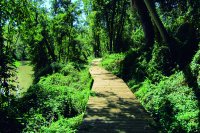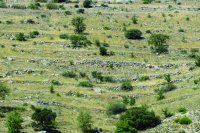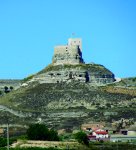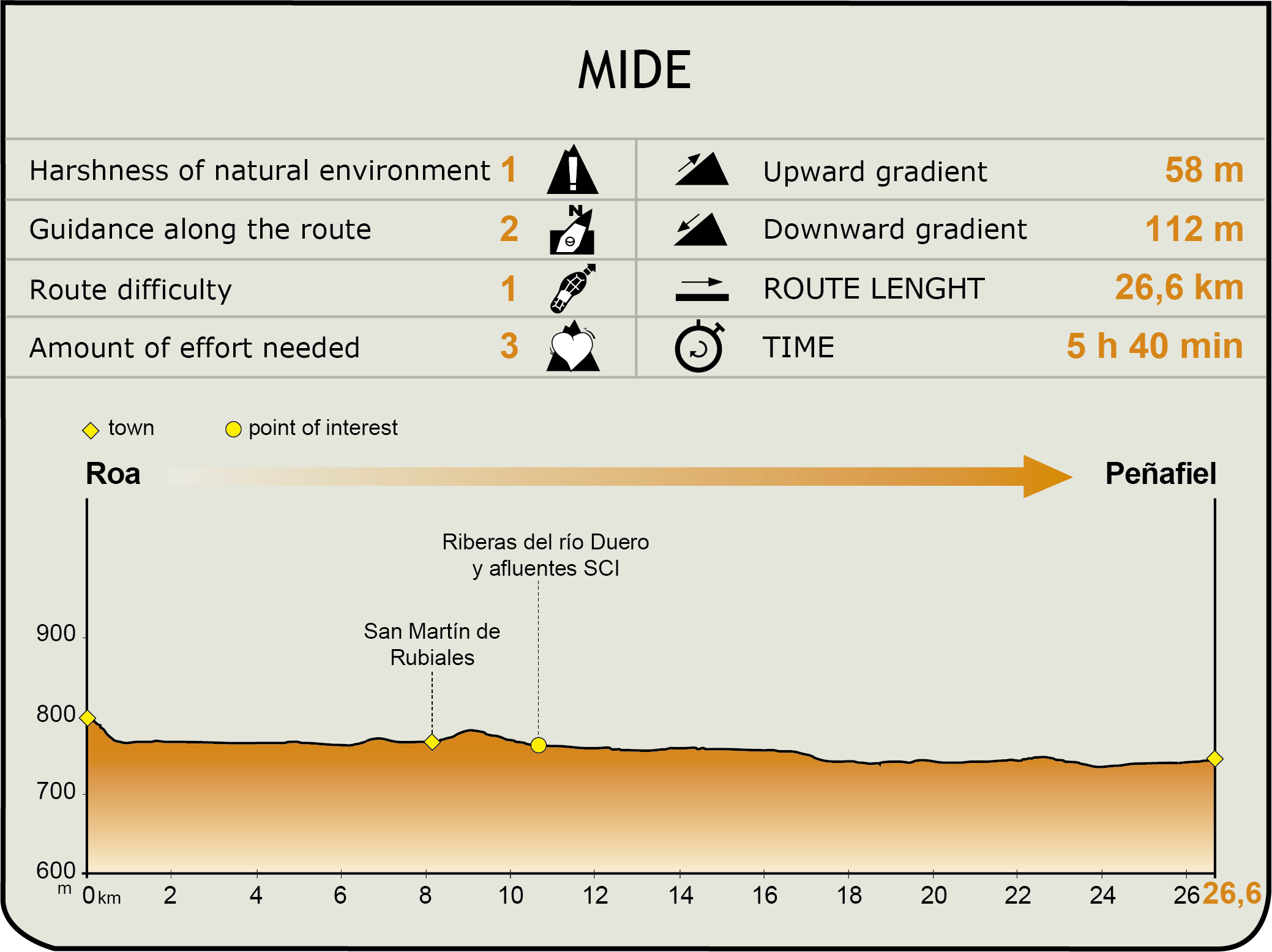Stage 11: Roa - Peñafiel
Description

Groves along the River Duero
Vineyards, groves and riparian forests along the River Duero take centre stage in this Stage. The route initially traverses through cereal and irrigated fields, as well as vineyards that produce the prestigious wines of the region. It then runs along a narrow path through dense riparian vegetation until Peñafiel. A visit to the majestic castle that looms above this riverside town is well worth the effort of this Stage.
The Stage starts at Roa, the town where the Regulatory Council of D.O. Ribera del Duero has its headquarters. The route leaves Burgos behind and ventures into the province of Valladolid.
A narrow country road leads down from Roa, high up on a promontory, to the flood plains of the River Duero, barely perceptible in the distance, and continues along Camino de los Molineros, which runs along the river.

At the first fork, the route turns to the left, then continues along the calm waters of the River Duero across a broad valley. Agriculture and market gardens run by local farmers, as well as the famous vineyards of this region, find fertile soil in these flat lands.
Through the dense riparian vegetation, one can get a glimpse of the town of La Cueva de Roa on the opposite bank of the River Duero, which despite its name does not have a single cave. The name dates back to the fifteenth century when King Henry IV granted the cities of Aranda, Molina, Atienza, Cuéllar and Roa, and the title of Duke of Alburquerque, to the nobleman Beltrán de la Cueva, as payment for his services. Since this town was in the parish of Roa, it was named La Cueva de Roa.
Further on, the route passes next to a dam. The Trail drifts away from the riverbank and continues through farmlands and vineyards on trellises until it arrives at a crossroads, where it turns left (southeast) towards another poplar, ash and willow forest along the River Duero.

To the right is Alto de Socastillo, a unique natural balcony over the meandering River Duero, with some of the best views in the area, although less famous other notorious natural viewpoints of the Burgalese Ribera del Duero, including La Cuesta Manvirgo, the town of Haza, or Cuesta del Águila. From this hill one can see the mosaic of fields spread across the Duero Valley, as far away as the mountains of Sierra de Ayllón.
The road turns right at another fork under the watchful eye of Alto de Socastillo, with the Shrine of San Juan in sight; a transit point to San Martín de Rubiales. Interestingly, when the River Duero served as a border between the Christian (north) and Muslin (south) territories, all the inhabitants of this town were massacred in the year 1000 after an intense siege by the troops of Abd er-Rahman III.
The route leaves the town past a row of wineries located at the foot of the hill that leads down from the moor to the valley. The Trail continues amidst vineyards and rain-fed and irrigated farms. Small elms (Ulmus minor) affected by Dutch elm disease provide shade on hot summer days.
One can see on the steep slopes the remains of the stone walls used in terraced agriculture. The abandonment of farming has enabled the natural regeneration of holm oaks and Spanish junipers, interspersed with old almond trees. Elsewhere, the reforestation with stone pines (Pinus pinea) has been a notable successful.
Owing to the Riaza Canal and better irrigation infrastructures, the lands produce bountiful harvests of chard, corn, alfalfa, etc. Gone are the days when agriculture yielded poor harvests.

Further on along the River Duero flood plains, the route arrives at Bocos de Duero, in the province of Valladolid, with a pleasant park with tables and fountains. The route continues along a wooden walkway along the River Duero, traversing through a riparian forest of English poplars (Populus nigra), alders (Alnus glutinosa), ashes (Fraxinus angustifolia) and scrubland.
Further on, the route follows a narrow path along the river, with an occasional steep slope that requires a little effort.
A variety of bird species takes refuge among the willows (Salix sp.), poplars, roses (Rosa sp.) and brambles (Rubus sp.). A wonderful habitat filled with singing birds and the hustle and bustle of life. The brambles are inhabited by Common Nightingales (Luscinia megarhynchos), European Robins (Erithacus rubecula), Melodious Warblers (Hippolais polyglotta) and Common Chiffchaffs (Phylloscopus collybita). The canopy is abuzz with Eurasian Golden Orioles (Oriolus oriolus), Chickadees (Parus major), Green Woodpeckers (Picus viridis) and Spotted Flycatchers (Muscicapa striata).
Time passes very quickly in this pleasant environment. The route arrives at Peñafiel even before one realises. Here the route crosses a road via an underpass leading to the confluence of the rivers Duero and Duratón, where the streams come together before reaching Peñafiel, the endpoint of this Stage. This town is famous for its castle and the medieval stone bridge on the river.
Profile

MIDE (Method for the Information of Excursions)
Featured
Further information
Ribera de Duero Appellation of Origin
Ribera del Duero is considered today one of the best wines in Spain with designation of origin. However, the relationship between Ribera del Duero and wine goes back a long way. Indeed, the god Bacchus is depicted in Roman mosaics discovered at Baños de Valdearados in 1972.
The Romans considered this sunny land with low rainfall ideal for growing grapes. Wine has influenced this land and its people since then. Vineyards give colour and texture to the landscape, and traditional wineries (from the 13th century) shaped the towns, becoming a key element of their economy and traditions.
Ribera del Duero was granted the Designation of Origin in 1982, with the headquarters of the Regulatory Board at Roa. There are currently over 200 wineries protected under the Designation of Origin, including some of the most prestigious brands in the country.
The variety of grape most widely used is local red or tempranillo (at least 75% of the grapes must be from these varietals). Red wine accounts for the bulk of the production, although rosé and white wine are also produced.
There are four Designation of Origin categories in red wines: young wine (aged for less than 12 months), Crianza (aged for not less than 24 months, 12 of which must be in oak barrels), Reserva (aged for not less than 36 months, 12 of which must be in oak barrels) and Gran Reserva (aged for not less than 60 months, 24 of which must be in oak barrels).
Dutch elm disease
Dutch elm disease decimates elms, leaving a trail of dried or stunted trees that eventually die when they are 2-3 metres high.
The disease is spread by a small insect, the elm bark beetle. As the beetle bores into the bark of an elm tree, and feeds on the tender branches, it introduces a fungus (Ceratocystis ulmi) into the tree's vascular system.
Although the elm eventually dies, the sticky spores of the Dutch elm fungus remain inside the tree and attach to the beetles inside the elm. The beetle spreads the spores when it moves to another elm, beginning a new cycle of propagation.


